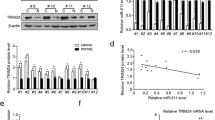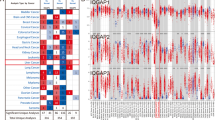Abstract
Purpose
Tripartite motif-containing protein 21 (TRIM21) has E3 ubiquitin ligase activity and is involved in the regulation of various biological processes in vivo. TRIM21 has been found to have strong associations with various cancers. However, its role in gastric cancer is unclear.
Methods
The TCGA database was screened to obtain TRIM21 using WGCNA and PPI analyses. The TCGA database was used to evaluate the correlation of TRIM21 expression with patients’ clinical characteristics, prognosis, functional enrichment and immune cell infiltration. The role of TRIM21 in cell proliferation, apoptosis and invasion was verified by in vivo and in vitro assays. The UCSC and JASPAR databases were used to evaluate the regulatory role of STAT1 on TRIM21 transcription. Finally, dual-luciferase reporter assay was used to confirm the regulation of TRIM21 transcriptional activity by STAT1.
Results
As a key gene, high expression of TRIM21 inhibited the gastric cancer growth and was significantly enriched in apoptosis, cell proliferation, and JAK/STAT signaling pathways. TRIM21 expression was positively correlated with a variety of TICs, including T cells, NK cells, and DCs. In vivo assays, TRIM21 inhibited functions in gastric cancer cell lines, including inhibition of proliferation and migration, and promotion of apoptosis. Database analysis and dual-luciferase reporter assay showed that STAT1 inhibited the transcriptional activity of TRIM21. In vivo assays confirmed that TRIM21 inhibited tumor growth, and STAT1 expression was negatively correlated with STAT1.
Conclusion
TRIM21 is a tumor-suppressive gene in gastric cancer, and its transcriptional activity is inhibited by STAT1.








Similar content being viewed by others
Data availability
The data generated and analyzed in this study were available.
References
Anderson WF, Rabkin CS, Turner N, Fraumeni JF Jr, Rosenberg PS, Camargo MC (2018) The changing face of noncardia gastric cancer incidence among US non-hispanic whites. J Natl Cancer Inst 110(6):608–615. https://doi.org/10.1093/jnci/djx262
Arnold M, Park JY, Camargo MC, Lunet N, Forman D, Soerjomataram I (2020) Is gastric cancer becoming a rare disease? A global assessment of predicted incidence trends to 2035. Gut 69(5):823–829. https://doi.org/10.1136/gutjnl-2019-320234
Balaji S, Ahmed M, Lorence E, Yan F, Nomie K, Wang M (2018) NF-κB signaling and its relevance to the treatment of mantle cell lymphoma. J Hematol Oncol 11(1):83. https://doi.org/10.1186/s13045-018-0621-5
Bindea G, Mlecnik B, Tosolini M, Kirilovsky A, Waldner M, Obenauf AC et al (2013) Spatiotemporal dynamics of intratumoral immune cells reveal the immune landscape in human cancer. Immunity 39(4):782–795. https://doi.org/10.1016/j.immuni.2013.10.003
Borlepawar A, Frey N, Rangrez AY (2019) A systematic view on E3 ligase Ring TRIMmers with a focus on cardiac function and disease. Trends Cardiovasc Med 29(1):1–8. https://doi.org/10.1016/j.tcm.2018.05.007
Brauner S, Zhou W, Backlin C, Green TM, Folkersen L, Ivanchenko M et al (2015) Reduced expression of TRIM21/Ro52 predicts poor prognosis in diffuse large B-cell lymphoma patients with and without rheumatic disease. J Intern Med 278(3):323–332. https://doi.org/10.1111/joim.12375
Brauner S, Jiang X, Thorlacius GE, Lundberg AM, Östberg T, Yan ZQ et al (2018) Augmented Th17 differentiation in Trim21 deficiency promotes a stable phenotype of atherosclerotic plaques with high collagen content. Cardiovasc Res 114(1):158–167. https://doi.org/10.1093/cvr/cvx181
Chen P, Tao L, Wang T, Zhang J, He A, Lam KH et al (2018) Structural basis for recognition of frizzled proteins by Clostridium difficile toxin B. Science 360(6389):664–669. https://doi.org/10.1126/science.aar1999
Crawford LJ, Johnston CK, Irvine AE (2018) TRIM proteins in blood cancers. J Cell Commun Signal 12(1):21–29. https://doi.org/10.1007/s12079-017-0423-5
Du S, Liew SS, Zhang CW, Du W, Lang W, Yao CCY et al (2020) Cell-permeant bioadaptors for cytosolic delivery of native antibodies: a “Mix-and-Go” approach. ACS Cent Sci 6(12):2362–2376. https://doi.org/10.1021/acscentsci.0c01379
Foss S, Bottermann M, Jonsson A, Sandlie I, James LC, Andersen JT (2019) TRIM21-from intracellular immunity to therapy. Front Immunol 10:2049. https://doi.org/10.3389/fimmu.2019.02049
Fuchs CS, Tomasek J, Yong CJ, Dumitru F, Passalacqua R, Goswami C et al (2014) Ramucirumab monotherapy for previously treated advanced gastric or gastro-oesophageal junction adenocarcinoma (REGARD): an international, randomised, multicentre, placebo-controlled, phase 3 trial. Lancet 383(9911):31–39. https://doi.org/10.1016/s0140-6736(13)61719-5
Fukuoka S, Hara H, Takahashi N, Kojima T, Kawazoe A, Asayama M et al (2020) regorafenib plus nivolumab in patients with advanced gastric or colorectal cancer: an open-label, dose-escalation, and dose-expansion phase Ib trial (REGONIVO, EPOC1603). J Clin Oncol 38(18):2053–2061. https://doi.org/10.1200/jco.19.03296
Hatakeyama S (2017) TRIM family proteins: roles in autophagy, immunity, and carcinogenesis. Trends Biochem Sci 42(4):297–311. https://doi.org/10.1016/j.tibs.2017.01.002
Heer EV, Harper AS, Sung H, Jemal A, Fidler-Benaoudia MM (2020) Emerging cancer incidence trends in Canada: the growing burden of young adult cancers. Cancer 126(20):4553–4562. https://doi.org/10.1002/cncr.33050
Hou Y, Li X, Li Q, Xu J, Yang H, Xue M et al (2018) STAT1 facilitates oestrogen receptor α transcription and stimulates breast cancer cell proliferation. J Cell Mol Med 22(12):6077–6086. https://doi.org/10.1111/jcmm.13882
Janjigian YY, Sanchez-Vega F, Jonsson P, Chatila WK, Hechtman JF, Ku GY et al (2018) Genetic predictors of response to systemic therapy in esophagogastric cancer. Cancer Discov 8(1):49–58. https://doi.org/10.1158/2159-8290.Cd-17-0787
Jones EL, Laidlaw SM, Dustin LB (2021) TRIM21/Ro52—roles in innate immunity and autoimmune disease. Front Immunol 12:738473. https://doi.org/10.3389/fimmu.2021.738473
Kawazoe A, Fukuoka S, Nakamura Y, Kuboki Y, Wakabayashi M, Nomura S et al (2020) Lenvatinib plus pembrolizumab in patients with advanced gastric cancer in the first-line or second-line setting (EPOC1706): an open-label, single-arm, phase 2 trial. Lancet Oncol 21(8):1057–1065. https://doi.org/10.1016/s1470-2045(20)30271-0
Kunishita Y, Yoshimi R, Kamiyama R, Kishimoto D, Yoshida K, Hashimoto E et al (2020) TRIM21 dysfunction enhances aberrant B-cell differentiation in autoimmune pathogenesis. Front Immunol 11:98. https://doi.org/10.3389/fimmu.2020.00098
Levental KR, Yu H, Kass L, Lakins JN, Egeblad M, Erler JT et al (2009) Matrix crosslinking forces tumor progression by enhancing integrin signaling. Cell 139(5):891–906. https://doi.org/10.1016/j.cell.2009.10.027
Marabelle A, Fakih M, Lopez J, Shah M, Shapira-Frommer R, Nakagawa K et al (2020) Association of tumour mutational burden with outcomes in patients with advanced solid tumours treated with pembrolizumab: prospective biomarker analysis of the multicohort, open-label, phase 2 KEYNOTE-158 study. Lancet Oncol 21(10):1353–1365. https://doi.org/10.1016/s1470-2045(20)30445-9
Mondaca S, Janjigian YY (2019) Application of positron emission tomography imaging to personalize esophagogastric cancer care. Cancer 125(8):1214–1217. https://doi.org/10.1002/cncr.31940
Nguyen JQ, Irby RB (2017) TRIM21 is a novel regulator of Par-4 in colon and pancreatic cancer cells. Cancer Biol Ther 18(1):16–25. https://doi.org/10.1080/15384047.2016.1252880
Ping M, Wang S, Guo Y, Jia J (2022) TRIM21 improves apatinib treatment in gastric cancer through suppressing EZH1 stability. Biochem Biophys Res Commun 586:177–184. https://doi.org/10.1016/j.bbrc.2021.07.040
Ren W, Wu S, Wu Y, Liu T, Zhao X, Li Y (2019) MicroRNA-196a/-196b regulate the progression of hepatocellular carcinoma through modulating the JAK/STAT pathway via targeting SOCS2. Cell Death Dis 10(5):333. https://doi.org/10.1038/s41419-019-1530-4
Sung H, Ferlay J, Siegel RL, Laversanne M, Soerjomataram I, Jemal A et al (2021) Global Cancer Statistics 2020: GLOBOCAN estimates of incidence and mortality worldwide for 36 cancers in 185 countries. CA Cancer J Clin 71(3):209–249. https://doi.org/10.3322/caac.21660
Tian X, Guan W, Zhang L, Sun W, Zhou D, Lin Q et al (2018) Physical interaction of STAT1 isoforms with TGF-β receptors leads to functional crosstalk between two signaling pathways in epithelial ovarian cancer. J Exp Clin Cancer Res 37(1):103. https://doi.org/10.1186/s13046-018-0773-8
Venuto S, Merla G (2019) E3 ubiquitin ligase TRIM proteins cells cell cycle and mitosis. Cells. https://doi.org/10.3390/cells8050510
Wilke H, Muro K, Van Cutsem E, Oh SC, Bodoky G, Shimada Y et al (2014) Ramucirumab plus paclitaxel versus placebo plus paclitaxel in patients with previously treated advanced gastric or gastro-oesophageal junction adenocarcinoma (RAINBOW): a double-blind, randomised phase 3 trial. Lancet Oncol 15(11):1224–1235. https://doi.org/10.1016/s1470-2045(14)70420-6
Yoshihara K, Shahmoradgoli M, Martínez E, Vegesna R, Kim H, Torres-Garcia W et al (2013) Inferring tumour purity and stromal and immune cell admixture from expression data. Nat Commun 4:2612. https://doi.org/10.1038/ncomms3612
Yu H, Pardoll D, Jove R (2009) STATs in cancer inflammation and immunity: a leading role for STAT3. Nat Rev Cancer 9(11):798–809. https://doi.org/10.1038/nrc2734
Zhang J, Wang F, Liu F, Xu G (2020) Predicting STAT1 as a prognostic marker in patients with solid cancer. Ther Adv Med Oncol 12:1758835920917558. https://doi.org/10.1177/1758835920917558
Zhang T, Wang B, Su F, Gu B, Xiang L, Gao L et al (2022) TCF7L2 promotes anoikis resistance and metastasis of gastric cancer by transcriptionally activating PLAUR. Int J Biol Sci 18(11):4560–4577. https://doi.org/10.7150/ijbs.69933
Funding
This study was supported by Major Science and Technology Project of Gansu Province (20ZD7FA003, 22ZD6FA050, 22JR9KA002); The Fundermental Research Funds for the Central Universities (lzujbky-2021-ct18); The Natural Science Foundation of Gansu Province under Grant (No. 20JR10RA732); The Science and Technology Program of Gansu province (No. 23JRRA1015); Fundamental Research Funds for the Central Universities (lzujbky-2022-sp08); Medical Innovation and Development Project of Lanzhou University (lzuyxcx-2022-154, lzuyxcx-2022-141), and Gansu Province Health Industry Scientific Research Project (GSWSKY-2019-66).
Author information
Authors and Affiliations
Contributions
Conceptualization, WH and YL; writing—original draft preparation, CH; writing—review and editing, XZ, YG, DW, FT, BZ, TL and WH; visualization, CH. All the authors have read and agreed to the published version of the manuscript.
Corresponding authors
Ethics declarations
Conflict of interest
The authors declare that the research was conducted in the absence of any commercial or financial relationships that could be construed as a potential conflict of interest.
Ethical approval
This study was approved by the Ethics committee of Lanzhou University Second Hospital (2021A-153 and D2021-136).
Additional information
Publisher's Note
Springer Nature remains neutral with regard to jurisdictional claims in published maps and institutional affiliations.
Supplementary Information
Below is the link to the electronic supplementary material.
Rights and permissions
Springer Nature or its licensor (e.g. a society or other partner) holds exclusive rights to this article under a publishing agreement with the author(s) or other rightsholder(s); author self-archiving of the accepted manuscript version of this article is solely governed by the terms of such publishing agreement and applicable law.
About this article
Cite this article
Huo, C., Gu, Y., Wang, D. et al. STAT1 suppresses the transcriptional activity of TRIM21 in gastric cancer. J Cancer Res Clin Oncol 149, 15335–15348 (2023). https://doi.org/10.1007/s00432-023-05307-8
Received:
Accepted:
Published:
Issue Date:
DOI: https://doi.org/10.1007/s00432-023-05307-8




